THE 1956 GOLDEN HAWK
OWNERS
REGISTER STORY
By Frank Ambrogio
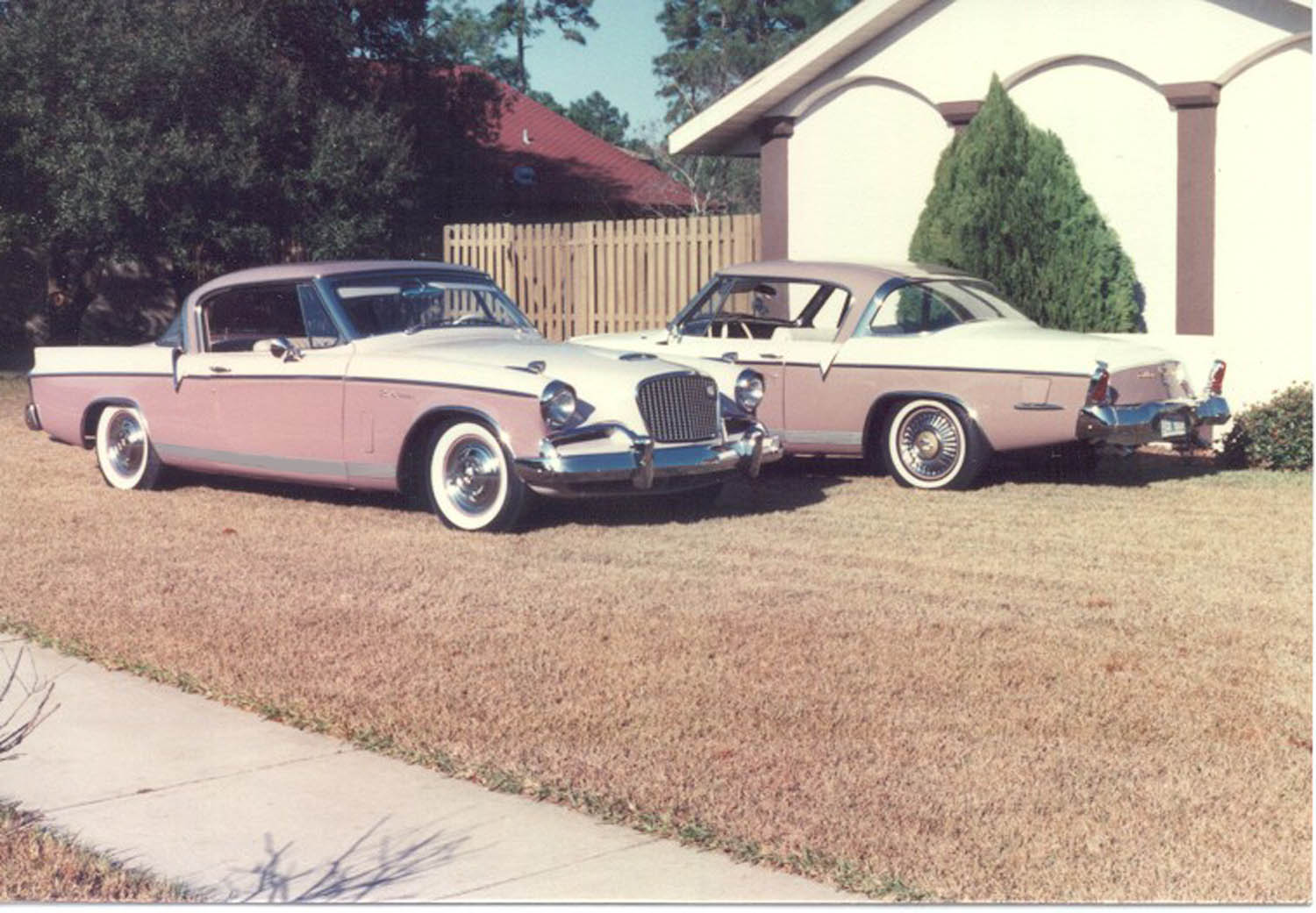 No matter which way you look at it, the 1956 Studebaker Golden Hawk
represents
one of the finest cars produced by the Studebaker-Packard Corporation.
With a "square up" styling update of the original Robert Bourke 1953
Starliner
design, and powered by Packard's potent 352 CID OHV V-8 engine, the 275
HP 1956 Studebaker Golden Hawk combined both style and performance in
one
very neat package while producing one of the highest
horsepower-to-weight
ratios of any 1956 American stock car.
No matter which way you look at it, the 1956 Studebaker Golden Hawk
represents
one of the finest cars produced by the Studebaker-Packard Corporation.
With a "square up" styling update of the original Robert Bourke 1953
Starliner
design, and powered by Packard's potent 352 CID OHV V-8 engine, the 275
HP 1956 Studebaker Golden Hawk combined both style and performance in
one
very neat package while producing one of the highest
horsepower-to-weight
ratios of any 1956 American stock car.
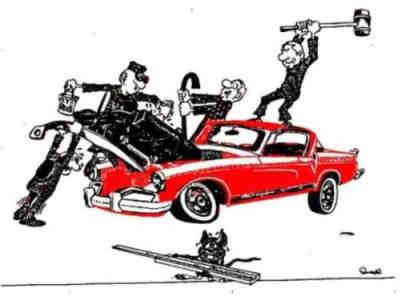 Topped
off with a Carter WCFB 4 barrel carburetor, drivers and passengers
alike
were not disappointed when the need for extra power presented itself.
An
optional dealer installed dual 4 barrel setup, borrowed from the
Packard
Caribbean, would get any driver's heart pumping.
Topped
off with a Carter WCFB 4 barrel carburetor, drivers and passengers
alike
were not disappointed when the need for extra power presented itself.
An
optional dealer installed dual 4 barrel setup, borrowed from the
Packard
Caribbean, would get any driver's heart pumping.
Whether coupled to Borg Warner's T85 3 speed/overdrive manual, or
Packard's
smooth Twin Ultramatic transmission, the 1956 Golden Hawk provided its
driver with sports car type performance and touring car comfort. The
Ultramatic,
mated to a 3.07:1 rear axle, gave plenty of rubber burning power, while
the buyer who opted for the manual transmission and 3.92:1 rear axle
could
expect to join the "frequent tire" program.
A bore of 4", stroke of 3.5", and a compression ratio of 9.5 to 1
produced
an advertised maximum torque of 380 lb. ft. at 2800 RPM. Despite the
power
and weight of the engine, the 1956 Golden Hawk could deliver economy in
the 16 to 22 MPG range, if the driver could exercise a little self
control.
The exterior dimensions were listed as: wheelbase 120-1/2", overall
length 204", height 57". Shipping weight was listed at 3360 lbs,
distributed
58% on the front wheels and 42% on the rear wheels. The new 12 volt
electrical
system featured a Willard 9 plate, 60-amp hours battery. The gas tank
would
reach the full mark at 18 gallons and the radiator overflowed beyond
26.5
qts. The steering ratio of 33.8 to 1 took 5¬ turns lock to lock
giving
a turning circle of 41 ft. curb to curb. The complete package was
supported
by front coil and, rear leaf springs, and rode on 7.10-15, 4 ply tires.
The fiberglass dashboard, with its engine-turned facing, featured
eye
pleasing, very legible, white numerals and indicators on black face,
Stewart
Warner gauges enhanced with clock, tachometer, and vacuum gauges as
standard
equipment. The 160 MPH speedometer and matching 6000 RPM tachometer
left
no doubt that S/P Corporation engineers expected this car to add a new
dimension to Studebaker's staid, economy image. Also standard, and
within
easy view of the driver, were oil pressure, water temperature, amp, and
fuel gauges. The absence of "idiot" lights meant the driver could
monitor
all major engine functions while secretly enjoying the admiring glances
from those who could only hope.
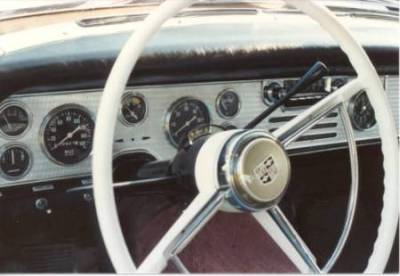
Other standard items included cigar lighter, glove compartment light,
electric windshield wipers, full hubcaps, Hill Holder (manual
transmissions
only), and dual exhaust system. The Hill Holder allowed the driver to
release
the brake pedal, while on an incline, without the car rolling
backwards.
The disengagement was accomplished when the clutch pedal was released.
A long list of options was available including internally controlled
radio antenna, manual or push button AM radio, rear seat speaker, power
steering, power brakes, power windows, front power seat, tinted glass,
wire hubcaps, and detachable trunk light. A somewhat unusual seat belt
option had the belts anchored to the doors while the inside belt
sections
were attached to the center floorboard. With finned brake drums for
extra
cooling, padded dash, and the optional seat belts, the 1956 Golden Hawk
added a degree of safety not offered by most of its competitors.
Interiors were quite luxurious with all vinyl interiors or vinyl
with
cloth inserts in a variety of colors and patterns and color coordinated
carpeting. Molded arm rests graced the door and rear seat side panels,
while the rear seats were separated by a fold-down center rear seat arm
rest, providing an eye pleasing, yet fully functional, extra dimension
of comfort.
Most drive reports gave the 1956 Golden Hawk high marks in almost
every
category. The instrument panel and controls, acceleration, and the
brake
system were consistently lauded. The April, 1956 issue of Mechanix
Illustrated
contained a report by Tom McCahill in which he said of the Hawk, "A
good-looking
car, extremely pleasant to drive." He also felt that more weight at the
rear end of the Hawk would improve handling and prevent wheel spin.
Through the years, much has been said about the excessive front end
weight and what that did to the steering, especially when going around
a curve. I think this has been overstated, especially for normal
driving,
as I have never experienced a problem on turns in either of my 1956
Golden
Hawks. Racer Brown reported the following in the April, 1956 issue of
Hot
Rod Magazine: "The tenacity with which our "Golden Hawk" stayed stuck
to
the road through the most violent road race maneuvers was considered
exceptional.
Only in the fastest turns did the rear end show any signs of "breaking
loose," this being a simple matter to correct. Although the front end
had
a "heavy" feel to it in turns, it showed no tendencies to "wash out"
into
a slide."
The parking lights were mounted on top of the front fenders and with
the modest fiberglass fins adorning the rear fenders, the 1956 Golden
Hawk
provided the driver with excellent judgment visibility for parking or
maneuvering in tight spaces.
The marriage of two orphans produced this illegitimate offspring
which
is the only car produced by Studebaker-Packard Corporation to combine
elements
unique to each of the original companies. Studebaker styling and
Packard
power just may have produced the first, or one of the first, muscle
cars.
The 1956 lease (and subsequent sale) of the Utica, Michigan Packard
engine plant to Curtiss-Wright meant the end of the short lived Packard
V-8 introduced with the 1955 Packards. A similar, but lower powered
engine
was also sold to American Motors Corporation for use in Nash Ambassador
and Hudson Hornet V-8 equipped models. AMC introduced its own V-8 on
March
5, 1956. The 190 HP, 250 CID AMC V-8 was used in Hudson and Nash models
for the remainder of the model year.
No other Studebaker was Packard powered. 1957 and 1958 Studebaker
Golden
Hawks were all powered by Studebaker's supercharged 289 V-8. 1957 and
1958
Packards, although fine automobiles, were actually Studebakers, powered
by Studebaker engines, and dressed with Packard script and some
leftover
Packard trim.
This Studebaker/Packard combination has been a source of some
frustration
to the 1956 Golden Hawk owner. Packard engine parts are not as readily
available as Studebaker engine parts. Although similar to Hawk models
of
other years, many body and trim parts are unique to 1956 Hawks only,
and
some exclusively to the 1956 Golden Hawk.
Because of this uniqueness, in January, 1989, I started the 1956
Studebaker
Golden Hawk Owners Register. Through the years, over 450 owners have
joined the fold including
members from Sweden, England, Scotland, Puerto Rico, Norway, Australia,
Switzerland, and Canada. Our present list of registered owners is in
the 250 range.
I publish a periodic newsletter called 56J
ONLY which includes letters
from members, tips, information on colors and options, and for sale and
want ads. I have had great response from the members and together we
have
provided information on solving a myriad of problems including noisy
lifters,
and tachometer malfunctions. We have also provided information on
radios,
decals, special tools, and frame strengthening.
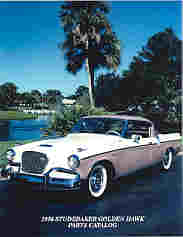 We
have
also been able to get the steering wheel remanufactured and in March
1994,
I completed a 4 year effort which produced The 1956 Studebaker
Golden
Hawk Parts Catalog. Included in
the 320 page catalog are parts drawings,
every part number used on the 1956 Golden Hawk, a list of service
bulletins,
list of accessory codes, and a list of all the nuts and bolts used to
hold
the various pieces together. To the best of my knowledge, this is the
only
catalog ever devoted to one particular year and model Studebaker.
We
have
also been able to get the steering wheel remanufactured and in March
1994,
I completed a 4 year effort which produced The 1956 Studebaker
Golden
Hawk Parts Catalog. Included in
the 320 page catalog are parts drawings,
every part number used on the 1956 Golden Hawk, a list of service
bulletins,
list of accessory codes, and a list of all the nuts and bolts used to
hold
the various pieces together. To the best of my knowledge, this is the
only
catalog ever devoted to one particular year and model Studebaker.
In May 1995, I was able to reproduce two tags which go under the
hood.
One goes on the generator field terminal, and the other goes on the
tachometer
sending unit switch. Both of these tags were virtually unknown prior to
their reproduction and would probably have been lost forever.
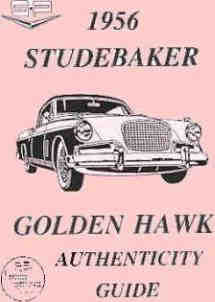 August 1996 was the date I completed the 1956 Studebaker
Golden Hawk
Authenticity Guide. The 70 page guide features 30 color photos and
color graphics showing all the engine compartment decals/appliqués. It
shows many of the little differences between these and other Hawk
models,
often times with supporting documentation.
August 1996 was the date I completed the 1956 Studebaker
Golden Hawk
Authenticity Guide. The 70 page guide features 30 color photos and
color graphics showing all the engine compartment decals/appliqués. It
shows many of the little differences between these and other Hawk
models,
often times with supporting documentation.
Check out these and other items in the Publications and Products
section
of this site. Simply click on Publications and Products from the
Options
page.
The newsletter, Parts Catalog, and the Authenticity guide are all
available on CD, and are also posted on the web site. Additionally, all
the original production orders, generated from our data base, are
available on CD. Copies of individual original production orders are
also available in hard copy form.
I maintain a roster of owners and occasionally print a list of all
car's
serial numbers and their last known whereabouts. I accomplish this by
requiring,
as dues, the car's serial and body numbers. To date we have located
about 450-500 cars which rest somewhere on the planet and hope to find
many more.
Some sources indicate that approximately 250 of this model survive, but
obviously, we now believe that number to be a little low.
I encourage any owner of a 1956 Studebaker Golden Hawk to complete
the
on-line registration form by clicking here or
from
the Options page. If you have more than one car, send the numbers from
all of them. There is room on the form for up to four cars. In return I
will send you an updated roster, a list of all the cars registered with
me, and information on how you can purchase all the back issues of 56J
ONLY.
If you own one of these cars, why not join the group in which
everyone
becomes an expert on the 1956 Studebaker Golden Hawk?
Select an option
Top of Page
Home
 No matter which way you look at it, the 1956 Studebaker Golden Hawk
represents
one of the finest cars produced by the Studebaker-Packard Corporation.
With a "square up" styling update of the original Robert Bourke 1953
Starliner
design, and powered by Packard's potent 352 CID OHV V-8 engine, the 275
HP 1956 Studebaker Golden Hawk combined both style and performance in
one
very neat package while producing one of the highest
horsepower-to-weight
ratios of any 1956 American stock car.
No matter which way you look at it, the 1956 Studebaker Golden Hawk
represents
one of the finest cars produced by the Studebaker-Packard Corporation.
With a "square up" styling update of the original Robert Bourke 1953
Starliner
design, and powered by Packard's potent 352 CID OHV V-8 engine, the 275
HP 1956 Studebaker Golden Hawk combined both style and performance in
one
very neat package while producing one of the highest
horsepower-to-weight
ratios of any 1956 American stock car.
 Topped
off with a Carter WCFB 4 barrel carburetor, drivers and passengers
alike
were not disappointed when the need for extra power presented itself.
An
optional dealer installed dual 4 barrel setup, borrowed from the
Packard
Caribbean, would get any driver's heart pumping.
Topped
off with a Carter WCFB 4 barrel carburetor, drivers and passengers
alike
were not disappointed when the need for extra power presented itself.
An
optional dealer installed dual 4 barrel setup, borrowed from the
Packard
Caribbean, would get any driver's heart pumping.

 We
have
also been able to get the steering wheel remanufactured and in March
1994,
I completed a 4 year effort which produced
We
have
also been able to get the steering wheel remanufactured and in March
1994,
I completed a 4 year effort which produced  August 1996 was the date I completed the 1956 Studebaker
Golden Hawk
Authenticity Guide. The 70 page guide features 30 color photos and
color graphics showing all the engine compartment decals/appliqués. It
shows many of the little differences between these and other Hawk
models,
often times with supporting documentation.
August 1996 was the date I completed the 1956 Studebaker
Golden Hawk
Authenticity Guide. The 70 page guide features 30 color photos and
color graphics showing all the engine compartment decals/appliqués. It
shows many of the little differences between these and other Hawk
models,
often times with supporting documentation.